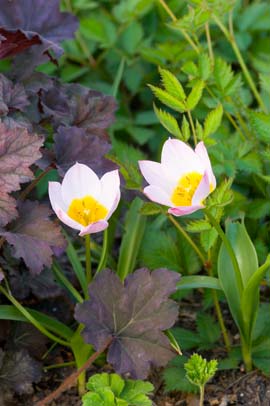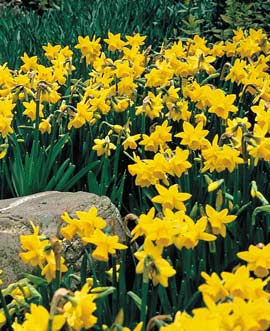It’s still summer, but if you want tulips, daffodils, hyacinths and other spring beauties, get them now. You can purchase bulbs at garden centers and big box stores, or you can order them from online retailers. The best selection, especially of unusual bulbs, will come from online merchants. You can plant them starting in late September until a few weeks before the ground freezes.
Bulbs are early, mid- and late-season bloomers. If your landscape is shady, opt for early to mid-season blooming bulbs. These present their show before trees and shrubs leaf out to cast shade.
 Lilac wonder tulip & frosted violet heuchera
Lilac wonder tulip & frosted violet heuchera
Photo courtesy Netherlands Flower Bulb Information Center
Plant bulbs among perennials. Companion perennials camouflage the bulb’s foliage, which should stay attached until it turns yellow or brown, called ripening. This process replenishes the bulbs for next year’s show. Scilla, glory-of-the-snow and species crocus do great when planted in the lawn. They bloom early enough that their foliage can be cut with the first lawn mowing.
‘Lilac Wonder’ (Tulipa bakeri), a species tulip, blends beautifully with the perennial ‘Frosted Violet’ coral bell (Heuchera). As the coral bell grows, it will camouflage the tulip’s foliage as it processes nutrients for next year’s show.
Reliable bloomers
For Midwesterners, most tulips are not nearly as reliable as other spring bulbs. Some tulips, especially the big, showy hybrids, tend to decline over about three years, resulting in foliage but no flowers. Tulips are inexpensive, so gardeners tend to plant some every year. Tulips are a great way to try new color themes in the landscape.
 ‘February Gold’ daffodils bloom early, making them a good choice for shady landscapes.
‘February Gold’ daffodils bloom early, making them a good choice for shady landscapes.
Photo courtesy Netherlands Flower Bulb Information Center
Species tulips, which are not quite as showy as the colorful hybrids, are very reliable. Look for Tulipa bakeri, T. praestans and T. turkestanica, fine selections for naturalizing that will last decades.
Tulips are lollipops for deer. Squirrels and voles have a preference for freshly planted tulip bulbs. You can use repellants for many four-legged critters, or cover the newly planted area with chicken wire and mulch to ward off those that dig.
Daffodils are toxic and animals seem to avoid them. In their favor, daffodils are extremely reliable, returning year after year to celebrate the new season. Dutch hyacinths and certain daffodils and tulips are fragrant, so plant those where you can enjoy the scent as you walk to the mailbox, on the way to the garage or by the front stoop.
 ‘Gipsy Queen’ Dutch hyacinth perfumes the spring air.
‘Gipsy Queen’ Dutch hyacinth perfumes the spring air.
Photo courtesy ColorBlends
Tips for buying bulbs:
- Bulbs are sized in centimeters. The higher the number, the larger the bulb. Smaller bulbs are good for naturalizing.
- Select the largest bulbs you can afford. Top grade daffodils will have two noses or growth points on one bulb.
- Select bulbs that are firm and without bruises. It’s not uncommon for tulips to lose their outer skin, called a tunic, but this does not affect its health.
Tips for planting bulbs:
- Plant the bulbs two to three times deeper than they are tall.
- No need to add fertilizer at planting, but once they start to show in spring, give the blooms a boost by top dressing with a granular plant food.
- Instead of individual holes, dig larger ones and plant bulbs in drifts, clusters or blocks for the best show.
- Water the bulbs after planting.
by Jo Ellen Meyers Sharp